A 2 μm Wavelength Band Low-Loss Spot Size Converter Based on Trident Structure on the SOI Platform
Abstract
:1. Introduction
2. SSC Design and Simulation
3. Experiment and Analysis
3.1. Experiment Setup and Characterization Results
3.2. Analysis of the Difference between the Simulation and Experiment Results
4. Conclusions
Author Contributions
Funding
Data Availability Statement
Acknowledgments
Conflicts of Interest
References
- Poletti, F.; Petrovich, M.N.; Richardson, D.J. Hollow-core photonic bandgap fibers: Technology and applications. Nanophotonics 2013, 2, 315–340. [Google Scholar] [CrossRef]
- Fokoua, E.N.; Mousavi, S.A.; Jasion, G.T.; Richardson, D.J.; Poletti, F. Loss in hollow-core optical fibers: Mechanisms, scaling rules, and limits. Adv. Opt. Photonics 2023, 15, 1–85. [Google Scholar] [CrossRef]
- Li, Z.; Heidt, A.M.; Daniel, J.M.; Jung, Y.; Alam, S.U.; Richardson, D.J. Thulium-doped fiber amplifier for optical communications at 2 µm. Opt. Express 2013, 21, 9289–9297. [Google Scholar] [CrossRef] [PubMed]
- Gaida, C.; Gebhardt, M.; Heuermann, T.; Wang, Z.; Jauregui, C.; Limpert, J. Transverse mode instability and thermal effects in thulium-doped fiber amplifiers under high thermal loads. Opt. Express 2021, 29, 14963–14973. [Google Scholar] [CrossRef] [PubMed]
- Olesberg, J.T. Noninvasive blood glucose monitoring in the 2.0–2.5/spl mu/m wavelength range. In Proceedings of the 14th Annual Meeting of the IEEE Lasers and Electro-Optics Society, San Diego, CA, USA, 12–13 November 2001. [Google Scholar]
- Reddy, V.S.; Agarwal, B.; Ye, Z.; Zhang, C.; Roy, K.; Chinnappan, A.; Narayan, R.J.; Ramakrishna, S.; Ghosh, R. Recent advancement in biofluid-based glucose sensors using invasive, minimally invasive, and non-invasive technologies: A review. Nanomaterials 2022, 12, 1082. [Google Scholar] [CrossRef] [PubMed]
- Wang, R.; Vasiliev, A.; Muneeb, M.; Malik, A.; Sprengel, S.; Boehm, G.; Amann, M.C.; Šimonytė, I.; Vizbaras, A.; Vizbaras, K.; et al. III–V-on-silicon photonic integrated circuits for spectroscopic sensing in the 2–4 μm wavelength range. Sensors 2017, 17, 1788. [Google Scholar] [CrossRef] [PubMed]
- Verma, N.; Bhardwaj, A. Biosensor technology for pesticides—A review. Appl. Biochem. Biotechnol. 2015, 175, 3093–3119. [Google Scholar] [CrossRef] [PubMed]
- Ma, H.; Yang, H.; Tang, B.; Wei, M.; Li, J.; Wu, J.; Zhang, P.; Sun, C.; Li, L.; Lin, H. Passive devices at 2 µm wavelength on 200 mm CMOS-compatible silicon photonics platform. Chin. Opt. Lett. 2021, 19, 071301. [Google Scholar] [CrossRef]
- Wu, W.; Ma, H.; Cai, X.; Han, B.; Li, Y.; Xu, K.; Lin, H.; Zhang, F.; Chen, Z.; Zhang, Z.; et al. High-speed carbon nanotube photodetectors for 2 μm communications. ACS Nano 2023, 17, 15155–15164. [Google Scholar] [CrossRef]
- Huo, N.; Gupta, S.; Konstantatos, G. MoS2–HgTe quantum dot hybrid photodetectors beyond 2 µm. Adv. Mater. 2017, 29, 1606576. [Google Scholar] [CrossRef]
- Wang, A.; Wang, S.; Zhang, S.; Cai, Y. Design and optimization of the grating coupler in the 2 µm band. Appl. Opt. 2023, 62, 1369–1375. [Google Scholar] [CrossRef] [PubMed]
- Lin, H.; Luo, Z.; Gu, T.; Kimerling, L.C.; Wada, K.; Agarwal, A.; Hu, J. Mid-infrared integrated photonics on silicon: A perspective. Nanophotonics 2017, 7, 393–420. [Google Scholar] [CrossRef]
- Quack, N.; Takabayashi, A.Y.; Sattari, H.; Edinger, P.; Jo, G.; Bleiker, S.J.; Errando-Herranz, C.; Gylfason, K.B.; Niklaus, F.; Khan, U.; et al. Integrated silicon photonic MEMS. Microsyst. Nanoeng. 2023, 9, 27. [Google Scholar] [CrossRef] [PubMed]
- Wang, Z.; Cai, Y.; Jiang, H.; Tian, Z.; Di, Z. Graphene-Based Silicon Photonic Devices for Optical Interconnects. Adv. Funct. Mater. 2023, 34, 2307461. [Google Scholar] [CrossRef]
- Sharma, T.; Wang, J.; Kaushik, B.K.; Cheng, Z.; Kumar, R.; Wei, Z.; Li, X. Review of recent progress on silicon nitride-based photonic integrated circuits. IEEE Access 2020, 8, 195436–195446. [Google Scholar] [CrossRef]
- Siew, S.Y.; Li, B.; Gao, F.; Zheng, H.Y.; Zhang, W.; Guo, P.; Xie, S.W.; Song, A.; Dong, B.; Luo, L.W.; et al. Review of silicon photonics technology and platform development. J. Light. Technol. 2021, 39, 4374–4389. [Google Scholar] [CrossRef]
- D’Mello, Y.; Reshef, O.; Bernal, S.; El-fiky, E.; Wang, Y.; Jacques, M.; Plant, D.V. Integration of periodic, sub-wavelength structures in silicon-on-insulator photonic device design. IET Optoelectron. 2020, 14, 125–135. [Google Scholar] [CrossRef]
- Nambiar, S.; Sethi, P.; Selvaraja, S.K. Grating-assisted fiber to chip coupling for SOI photonic circuits. Appl. Sci. 2018, 8, 1142. [Google Scholar] [CrossRef]
- Mu, X.; Wu, S.; Cheng, L.; Fu, H.Y. Edge couplers in silicon photonic integrated circuits: A review. Appl. Sci. 2020, 10, 1538. [Google Scholar] [CrossRef]
- Marchetti, R.; Lacava, C.; Carroll, L.; Gradkowski, K.; Minzioni, P. Coupling strategies for silicon photonics integrated chips. Photonics Res. 2019, 7, 201–239. [Google Scholar] [CrossRef]
- Barwicz, T.; Lichoulas, T.W.; Taira, Y.; Martin, Y.; Takenobu, S.; Janta-Polczynski, A.; Numata, H.; Kimbrell, E.L.; Nah, J.W.; Peng, B.; et al. Automated, high-throughput photonic packaging. Opt. Fiber Technol. 2018, 44, 24–35. [Google Scholar] [CrossRef]
- Larrea, R.; Gutierrez, A.M.; Griol, A.; Brimont, A.; Sanchis, P. Fiber-to-chip spot-size converter for coupling to silicon waveguides in the O-band. IEEE Photonics Technol. Lett. 2018, 31, 31–34. [Google Scholar] [CrossRef]
- Shiraishi, K.; Yoda, H.; Ohshima, A.; Ikedo, H.; Tsai, C.S. A silicon-based spot-size converter between single-mode fibers and Si-wire waveguides using cascaded tapers. Appl. Phys. Lett. 2007, 91, 141120. [Google Scholar] [CrossRef]
- Bhandari, B.; Im, C.S.; Lee, K.P.; Kim, S.M.; Oh, M.C.; Lee, S.S. Compact and broadband edge coupler based on multi-stage silicon nitride tapers. IEEE Photonics J. 2020, 12, 6602511. [Google Scholar] [CrossRef]
- Hatori, N.; Shimizu, T.; Okano, M.; Ishizaka, M.; Yamamoto, T.; Urino, Y.; Mori, M.; Nakamura, T.; Arakawa, Y. A hybrid integrated light source on a silicon platform using a trident spot-size converter. J. Light. Technol. 2014, 32, 1329–1336. [Google Scholar] [CrossRef]
- Chen, Z.; Chen, C.; Xu, H. An Efficient Three-Waveguide Spot Size Converter Using 180 nm Silicon Photonic Process Node. In Proceedings of the Eighth Symposium on Novel Photoelectronic Detection Technology and Applications, Kunming, China, 9–11 November 2021. [Google Scholar]
- Mu, X.; Wu, S.; Cheng, L.; Tu, X.; Fu, H.Y. A Compact Adiabatic Silicon Photonic Edge Coupler Based on Silicon Nitride/Silicon Trident Structure. In Proceedings of the 18th International Conference on Optical Communications and Networks (ICOCN), Huangshan, China, 5–8 August 2019. [Google Scholar]
- He, A.; Guo, X.; Wang, T.; Su, Y. Ultracompact fiber-to-chip metamaterial edge coupler. ACS Photonics 2021, 8, 3226–3233. [Google Scholar] [CrossRef]
- Shen, W.; Du, J.; Xiong, J.; Ma, L.; He, Z. Silicon-integrated dual-mode fiber-to-chip edge coupler for 2 × 100 Gbps/lambda MDM optical interconnection. Opt. Express 2020, 28, 33254–33262. [Google Scholar] [CrossRef]
- Fang, Q.; Song, J.; Luo, X.; Yu, M.; Lo, G.; Liu, Y. Mode-size converter with high coupling efficiency and broad bandwidth. Opt. Express 2011, 19, 21588–21594. [Google Scholar] [CrossRef]
- Loh, T.H.; Wang, Q.; Ng, K.T.; Lai, Y.C.; Ho, S.T. CMOS compatible integration of Si/SiO2 multilayer GRIN lens optical mode size converter to Si wire waveguide. Opt. Express 2012, 20, 14769–14778. [Google Scholar] [CrossRef]
- Lai, Y.; Yu, Y.; Fu, S.; Xu, J.; Shum, P.P.; Zhang, X. Efficient spot size converter for higher-order mode fiber-chip coupling. Opt. Lett. 2017, 42, 3702–3705. [Google Scholar] [CrossRef]
- Wang, X.; Shen, W.; Li, W.; Liu, Y.; Yao, Y.; Du, J.; Song, Q.; Xu, K. High-speed silicon photonic Mach–Zehnder modulator at 2 μm. Photonics Res. 2021, 9, 535–540. [Google Scholar] [CrossRef]
- Xu, S.; Dong, Y.; Zheng, S.; Zhong, Q.; Hu, T. Ultra-Compact Fiber-to-Chip Metasurface-Based Edge Coupler. In Proceedings of the 2022 Asia Communications and Photonics Conference (ACP), Shenzhen, China, 5–8 November 2022. [Google Scholar]
- Ye, N.; Gleeson, M.; Yang, H.; Zhang, H.; Roycroft, B.; Thomas, K.; Gocalinska, A.; Pelucchi, E.; Li, Z.; Richardson, D.; et al. Demonstration of 90° optical hybrid at 2 μm wavelength range based on 4 × 4 MMI using diluted waveguide. In Proceedings of the European Conference on Optical Communication (ECOC), Cannes, France, 21–25 September 2014. [Google Scholar]
- Available online: http://www.cxfiber.com/product/10.html (accessed on 15 January 2024).
- Butov, O.V.; Golant, K.M.; Tomashuk, A.L.; Van Stralen, M.J.; Breuls, A.H. Refractive index dispersion of doped silica for fiber optics. Opt. Commun. 2002, 213, 301–308. [Google Scholar] [CrossRef]
- Papes, M.; Cheben, P.; Benedikovic, D.; Schmid, J.H.; Pond, J.; Halir, R.; Ortega-Moñux, A.; Wangüemert-Pérez, G.; Winnie, N.Y.; Xu, D.X.; et al. Fiber-chip edge coupler with large mode size for silicon photonic wire waveguides. Opt. Express 2016, 24, 5026–5038. [Google Scholar] [CrossRef]
- Available online: https://service.cumec.cn/csip180al (accessed on 10 December 2023).
- Ye, N. High Speed Photodiode and 90° Optical Hybrid for 2 µm Optical Communication Systems. Ph.D. Thesis, University College, Cork, Ireland, 2016. [Google Scholar]


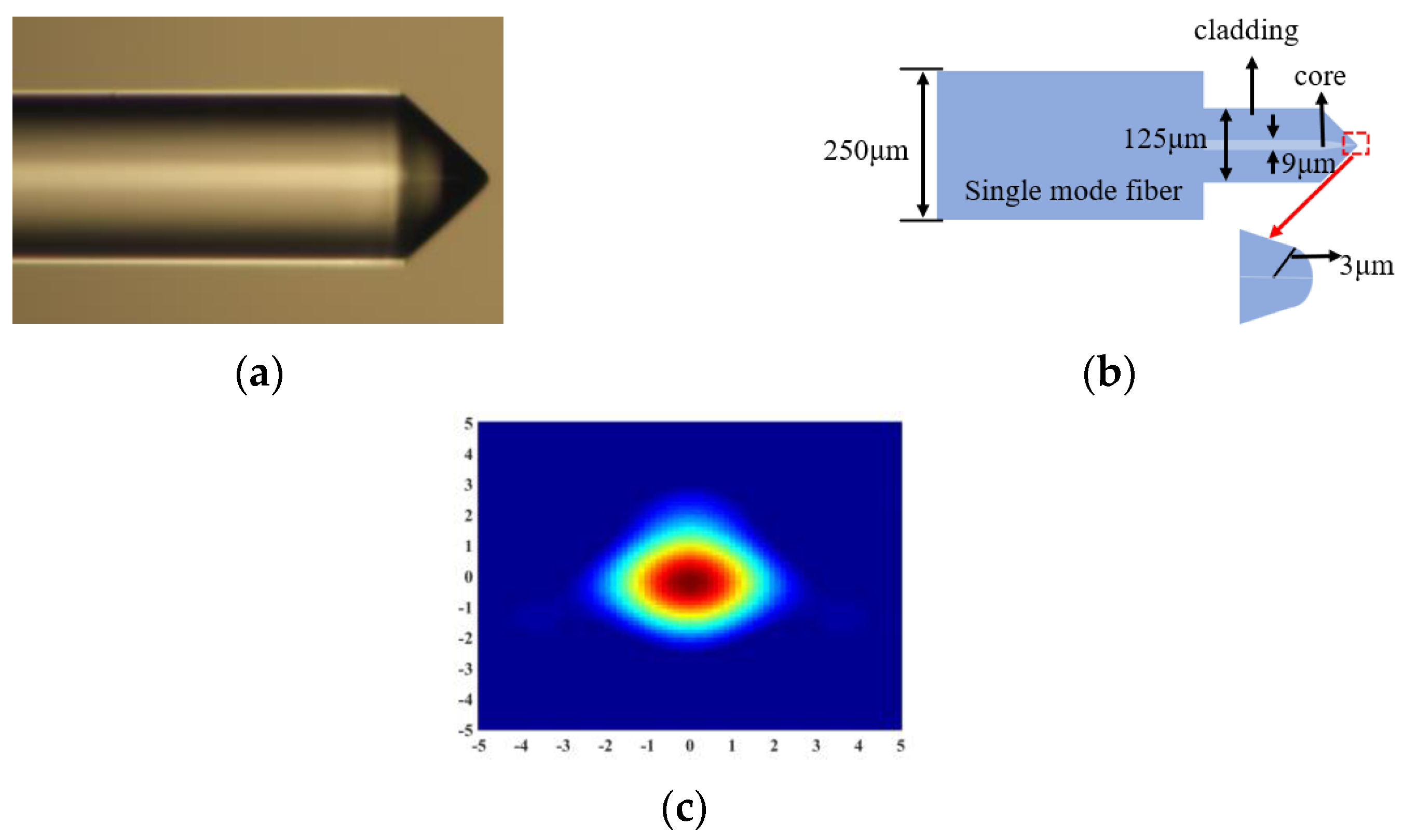
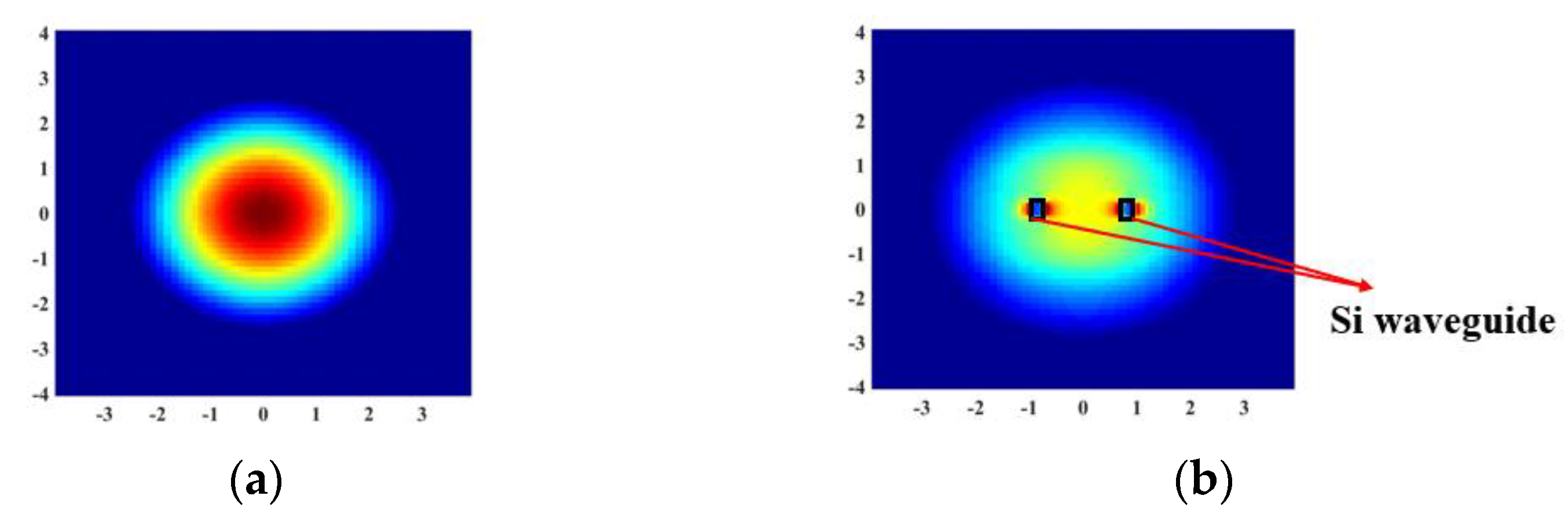

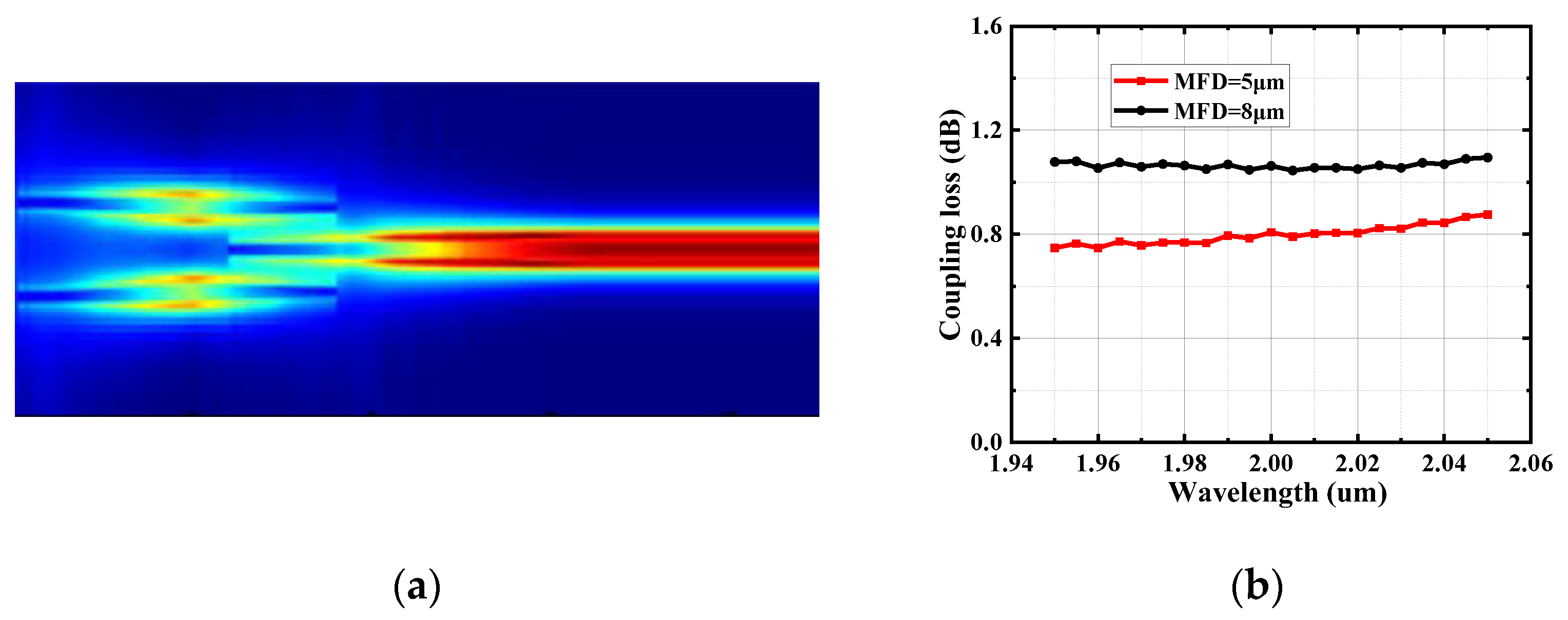
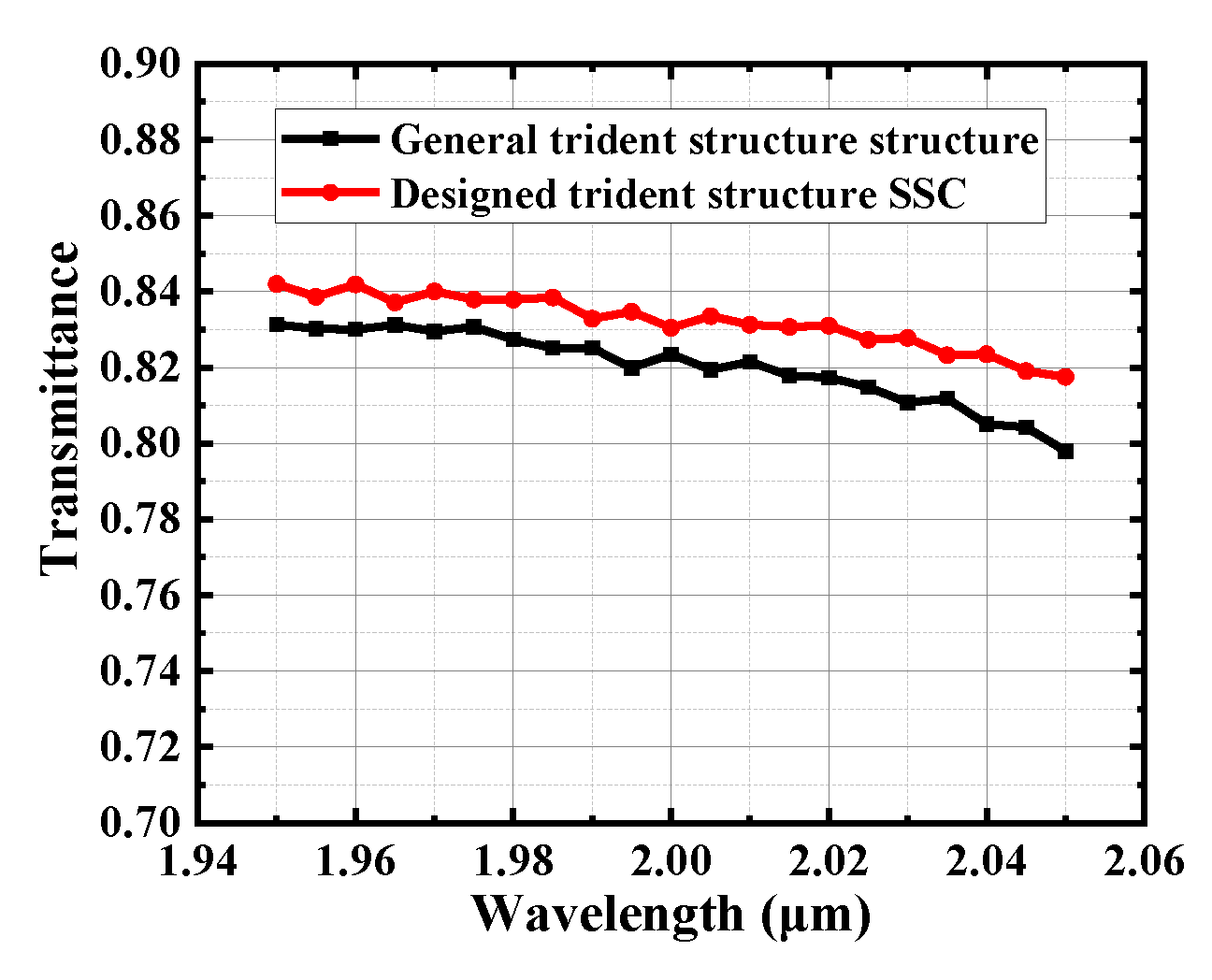
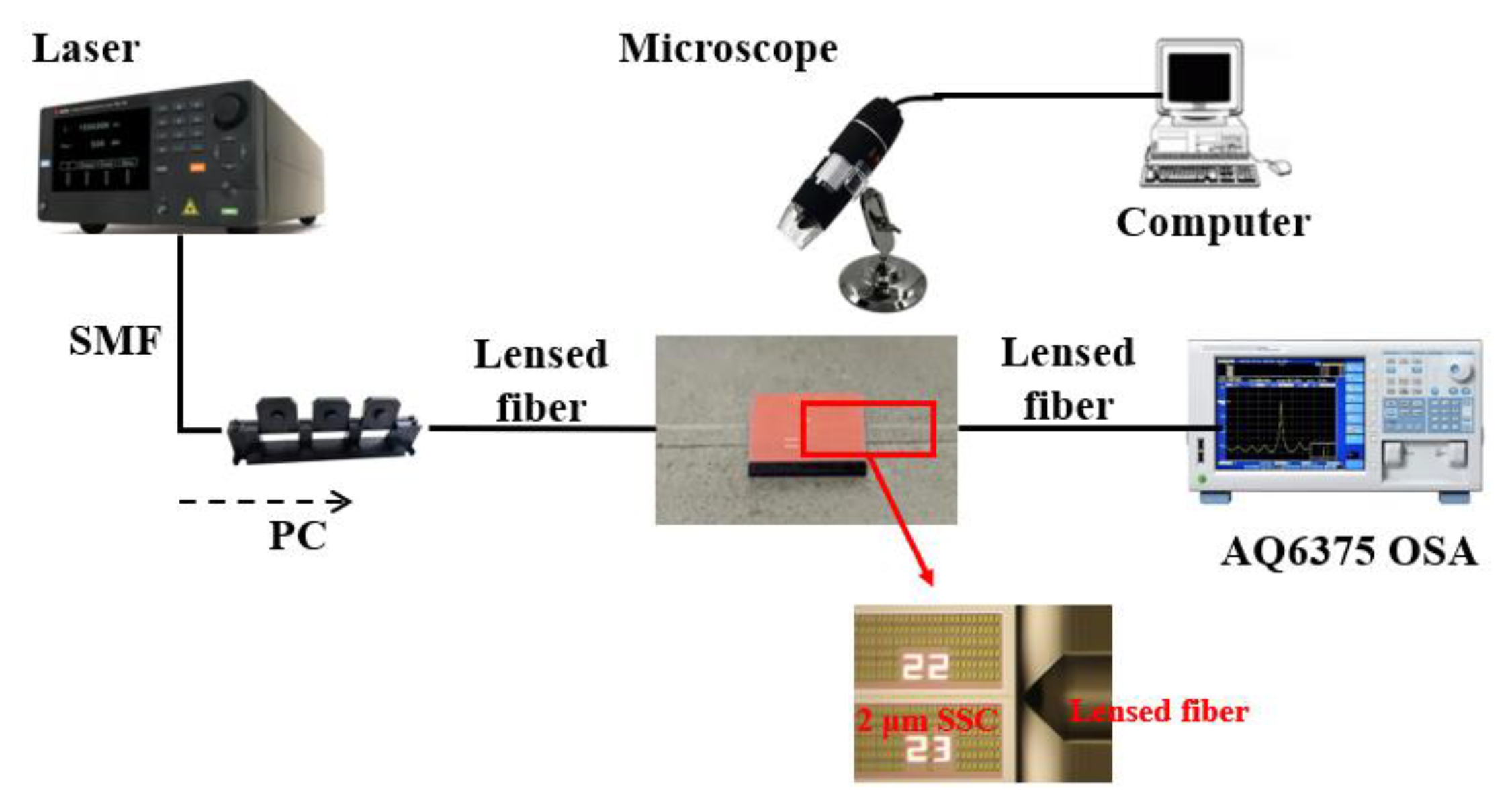


| Parameter | Value |
|---|---|
| a1 | 0.49211 |
| a2 | 0.62925 |
| a3 | 0.59202 |
| b1 | 0.04807 |
| b2 | 0.11275 |
| b3 | 8.29299 |
| Parameter | Value |
|---|---|
| Wtip | 0.22 μm |
| Wgap | 1.5 μm |
| L1 | 80 μm |
| L2 | 200 μm |
| Loss (min) | |
|---|---|
| Total loss/facet | 2.55 dB |
| Loss of the coupling lensed fiber/end | 0.75 dB |
| Loss of the straight waveguide (1.5 dB/cm [40])/facet | 0.375 dB |
| Loss of the device/facet | 1.425 dB |
Disclaimer/Publisher’s Note: The statements, opinions and data contained in all publications are solely those of the individual author(s) and contributor(s) and not of MDPI and/or the editor(s). MDPI and/or the editor(s) disclaim responsibility for any injury to people or property resulting from any ideas, methods, instructions or products referred to in the content. |
© 2024 by the authors. Licensee MDPI, Basel, Switzerland. This article is an open access article distributed under the terms and conditions of the Creative Commons Attribution (CC BY) license (https://creativecommons.org/licenses/by/4.0/).
Share and Cite
Wang, Z.; Xu, C.; Shi, Z.; Ye, N.; Guo, H.; Pang, F.; Song, Y. A 2 μm Wavelength Band Low-Loss Spot Size Converter Based on Trident Structure on the SOI Platform. Micromachines 2024, 15, 530. https://doi.org/10.3390/mi15040530
Wang Z, Xu C, Shi Z, Ye N, Guo H, Pang F, Song Y. A 2 μm Wavelength Band Low-Loss Spot Size Converter Based on Trident Structure on the SOI Platform. Micromachines. 2024; 15(4):530. https://doi.org/10.3390/mi15040530
Chicago/Turabian StyleWang, Zhutian, Chenxi Xu, Zhiming Shi, Nan Ye, Hairun Guo, Fufei Pang, and Yingxiong Song. 2024. "A 2 μm Wavelength Band Low-Loss Spot Size Converter Based on Trident Structure on the SOI Platform" Micromachines 15, no. 4: 530. https://doi.org/10.3390/mi15040530





